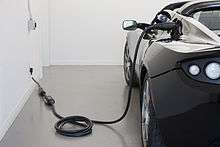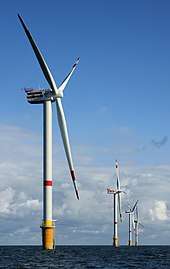Environmental technology
Environmental technology (envirotech), green technology (greentech) or clean technology (cleantech) is the application of one or more of environmental science, green chemistry, environmental monitoring and electronic devices to monitor, model and conserve the natural environment and resources, and to curb the negative impacts of human involvement. The term is also used to describe sustainable energy generation technologies such as photovoltaics, wind turbines, bioreactors, etc. Sustainable development is the core of environmental technologies. The term environmental technologies is also used to describe a class of electronic devices that can promote sustainable management of resources.

Examples
- Biofiltration
- Bioreactor
- Bioremediation
- Desalination
- Doubly fed electric machine
- Energy conservation
- Energy saving modules
- Electric vehicles
- Wave energy
- Green computing
- Hydroelectricity
- Wind power
- Wind turbine
- Hydrogen fuel cell
- Ocean thermal energy conversion
- Solar power
- Photovoltaic
- Thermal depolymerization
- Composting toilet
- Pyrolysis
Renewable energy
Renewable energy is the energy that can be replenished easily. For years we have been using sources such as wood, sun, water, etc. for means for producing energy. Energy that can be produced by natural objects like sun, wind, etc. is considered to be renewable. Technologies that have been in usage include wind power, hydropower, solar energy, geothermal energy, and biomass/bioenergy.
Water purification
Water purification: The whole idea/concept of having dirt/germ/pollution free water flowing throughout the environment. Many other phenomena lead from this concept of purification of water. Water pollution is the main enemy of this concept, and various campaigns and activists have been organized around the world to help purify water.[1]
Air purification
Air purification: Basic and common green plants can be grown indoors to keep the air fresh because all plants remove CO2 and convert it into oxygen. The best examples are: Dypsis lutescens, Sansevieria trifasciata, and Epipremnum aureum.[2] Besides using the plants themselves, some species of bacteria can also be added to the leaves of these plants to help remove toxic gases, such as toluene[3][4]
Sewage treatment
Sewage treatment is conceptually similar to water purification. Sewage treatments are very important as they purify water per levels of pollution. The most polluted water is not used for anything, and the least polluted water is supplied to places where water is used affluently. It may lead to various other concepts of environmental protection, sustainability, etc.[5]
Environmental remediation
Environmental remediation is the removal of pollutants or contaminants for the general protection of the environment. This is accomplished by various chemical, biological, and bulk methods.[6]
Solid waste management

Solid waste management is the purification, consumption, reuse, disposal and treatment of solid waste that is undertaken by the government or the ruling bodies of a city/town.[7]
eGain forecasting
Egain forecasting is a method using forecasting technology to predict the future weather's impact on a building.[8] By adjusting the heat based on the weather forecast, the system eliminates redundant use of heat, thus reducing the energy consumption and the emission of greenhouse gases.[9]
Energy conservation
Energy conservation is the utilization of devices that require smaller amounts of energy in order to reduce the consumption of electricity. Reducing the use of electricity causes less fossil fuels to be burned to provide that electricity.
Alternative and clean power

Principles:
- Green syndicalism
- Sustainability
- Sustainable design
- Sustainable engineering
Concerns over pollution and greenhouse gases have spurred the search for sustainable alternatives to our current fuel use. For example, biogas from anaerobic digestion of plant waste can be stored to produce heat or electricity. The global reduction of greenhouse gases requires the adoption of energy conservation as well as sustainable generation. That environmental harm reduction involves global changes such as:
- reducing air pollution and methane from biomass
- virtually eliminating fossil fuels for vehicles, heat, and electricity, left in the ground.
- widespread use of public transport, battery and fuel cell vehicles
- more wind/solar/water generated electricity
- reducing peak demands with carbon taxes and time of use pricing.
Since fuel used by industry and transportation account for the majority of world demand, by investing in conservation and efficiency (using less fuel), pollution and greenhouse gases from these two sectors can be reduced around the globe. Advanced energy efficient electric motor (and electric generator) technology that are cost effective to encourage their application, such as variable speed generators and efficient energy use, can reduce the amount of carbon dioxide (CO2) and sulfur dioxide (SO2) that would otherwise be introduced to the atmosphere, if electricity were generated using fossil fuels. Greasestock is an event held yearly in Yorktown Heights, New York which is one of the largest showcases of environmental technology in the United States.[10][11][12][13][14] Some scholars have expressed concern that the implementation of new environmental technologies in highly-developed national economies may cause economic and social disruption in less-developed economies.[15]
Education
Courses aimed at developing graduates with some specific skills in environmental systems or environmental technology are becoming more common and fall into three broads classes:
- Environmental Engineering or Environmental Systems courses oriented towards a civil engineering approach in which structures and the landscape are constructed to blend with or protect the environment;
- Environmental chemistry, sustainable chemistry or environmental chemical engineering courses oriented towards understanding the effects (good and bad) of chemicals in the environment. Such awards can focus on mining processes, pollutants and commonly also cover biochemical processes;
- Environmental technology courses oriented towards producing electronic, electrical or electrotechnology graduates capable of developing devices and artefacts able to monitor, measure, model and control environmental impact, including monitoring and managing energy generation from renewable sources, and developing novel energy generation technologies.
See also
- Appropriate technology
- Groasis Waterboxx
- The All-Earth Ecobot Challenge
- Pulser Pump
- Environmentally friendly
- Sustainable living
- Sustainable energy
- Sustainable design
- Ecotechnology
- Information and communication technologies for environmental sustainability
- Sustainable engineering
- Sustainable technologies
- Technology for sustainable development
References
- Recycling”. Retrieved June 15th, 2009. http://earth911.com/recycling/. “Recycle.gif”. Retrieved June 15th, 2009. "Archived copy". Archived from the original on 2012-11-23. Retrieved 2009-06-24.CS1 maint: archived copy as title (link) “What is Water Purification”. Retrieved June 16th, 2009, “Sewage Treatment”. Retrieved June 17th, 2009 "Archived copy". Archived from the original on 2009-03-26. Retrieved 2009-06-24.CS1 maint: archived copy as title (link) “Environmental Remedies and water Resource
- Kamal Meattle on how to grow fresh air TED (conference)
- EOS magazine, February 2017; Azalea's with extra bacteria can help to degrade toluene
- Bacteria on Hedera helix able to help degrade exhaust gases from Diesel engines running on Diesel
- “Sewage Treatment”. Retrieved June 17th, 2009 "Archived copy". Archived from the original on 2009-03-26. Retrieved 2009-06-24.CS1 maint: archived copy as title (link) “Environmental remedies and water Resource"
- Livescience. Retrieved June 27, 2009.10 top emerging environmental technologies. http://www.reference.md/files/D052/mD052918.html
- Retrieved June 16th, 2009. "Archived copy". Archived from the original on 2009-06-12. Retrieved 2009-06-24.CS1 maint: archived copy as title (link) “Urban Waste Management”. Retrieved June 16th, 2009. http://web.worldbank.org/WBSITE/EXTERNAL/TOPICS/EXTURBANDEVELOPMENT/EXTUSWM%5B%5D
- Taesler, R. (1990/91) Climate and Building Energy Management. Energy and Buildings, Vol. 15-16, pp 599 - 608.
- United States Patent 6098893 Comfort control system incorporating weather forecast data and a method for operating such a system (Inventor Stefan Berglund)
- Norman, Jim. "Where There’s Never an Oil Shortage". The New York Times. May 13, 2007.
- Tillman, Adriane. "Greasestock Festival returns, bigger and better Archived 2008-05-18 at the Wayback Machine". May 14, 2008.
- "Greasestock 2008 Archived 2008-05-29 at the Wayback Machine". Greasestock . Retrieved May 20, 2008.
- Max, Josh. "Gas-guzzlers become veggie delights at Greasestock in Yorktown Heights". Daily News. May 13, 2008.
- "Greasestock 2008: Alternative Fuel, Fun and French Fries Archived 2008-05-29 at the Wayback Machine". Natural Awakenings. May 2008.
- Eric Bonds and Liam Downey, "“Green” Technology and Ecologically Unequal Exchange: The Environmental and Social Consequences of Ecological Modernization in the World-System" in: Journal of World-Systems Research, Volume 18, Issue 2 (http://jwsr.pitt.edu/ojs/index.php/jwsr/article/view/482)
Further reading
- OECD Studies on Environmental Innovation Invention and Transfer of Environmental Technologies. OECD. September 2011. ISBN 978-92-64-11561-3.
External links
| Wikiversity has learning resources about Appropriate technology Designs |

